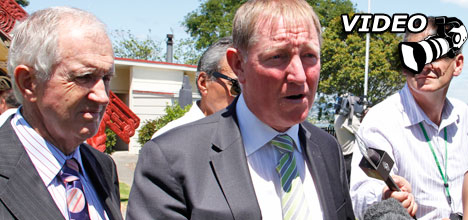A new long term recovery plan to restore the Bay of Plenty environment to the state it was in before the Rena disaster is estimated to cost up to $3million.
Environment Minister Nick Smith launched the new environmental recovery plan at the Waikari Marae in Matapihi today.
He estimates the plan will cost $2-3million, but emphasises this figure is an estimate and could change.
Environment Minister Nick Smith and Bay of Plenty Regional Council chair John Cronin launch the new environmental recovery plan to deal with the clean up from the Rena.
'This is just an estimate; as we know, the Rena incident is not over, the events are still unfolding.
'The final costs will not be determined until the whole Rena incident is finalised.”
The Rena ran aground on Astrolabe Reef, about 25km off the coast of Tauranga, on October 5 – spilling more than 350 tonnes of oil into the sea.
Nick says it is the government's objective for the full cost of the long-term recovery to be met by those responsible for the ship's grounding.
'We intend to recover as much as possible from those responsible – the ship's owners and insurers.
'However, we are not going to let that delay us in getting the work done.”
Nick says he cannot give details of the negotiations to recover the costs of the disaster.
'There are very sensitive discussions going on between the government, the ship's owners and insurers.”
The Rena recovery is already estimated to have cost $20million.
It is expected the majority of the work outlined in the long-term plan will be completed in 12 months time, however, Nick says this depends on the Rena salvage operation.
'It may have to be extended. There are still questions about how to get the containers off.
'This is not a final plan; it is going to evolve as the Rena unfolds.
'As we have seen with overseas incidents, sometimes it can take between two and three years. This is an initial plan that will need to be monitored.”
Video by Tracy Hardy
Nick says regular reviews will be given to the community as progress is made, with the first review expected in September 2012.
The 44-point long-term plan outlines a set of objectives and the actions that will be taken to restore the beaches, seabed, water, fisheries, wildlife and management of waste – and who will be responsible for this.
'It's about an ongoing programme that tracks the progress and gets the environment back to normal.
'I'm confident it will get back to normal.”
Nick says the key to this plan is making sure there are clear goals and ensuring no doubling up in resources.
'What this does is, it outlines exactly what it is the council will be responsible for, what DOC will be doing, what iwi are going to be doing, what is expected of habitat restoration.”
The plan includes recovery of areas from the Eastern Bay of Plenty through to beaches north of Waihi and into the Waikato.
The hardest environments to restore are expected to be the rocky coastlines, Motiti Island and the area around where Rena was grounded on Astrolabe Reef.
The plan has been created following in-depth discussions between government authorities, city and regional councils, environmental organisations and iwi.
Bay of Plenty Regional Council chair John Cronin says the long-term plan is the first step in moving into the second phase of the Rena incident.
'We are moving from response into the second phase of dealing with the restoration.”
John is proud of the way the wider Bay of Plenty community has handled the Rena grounding and subsequent events.
'This is a step forward. We have never come together like this before, where there has been such a display of cooperation; where iwi, the public and councils work together for a common goal.”
Te Moana A Toi Iwi Forum chair Charlie Tawhaio says the long-term plan is an example of how iwi and government officials can work together.
'This is another step forward. Those of us who have been working on this for a long time see it as an example of what can be achieved when iwi and government work together.”
Former Maritime New Zealand chief executive Catherine Taylor has been appointed the recovery manager and will be responsible for the delivery of the plan, to be assisted by a Tauranga-based project team.
The plan will also be overseen by a governance group, consisting of representatives of local and central government and iwi.



1 comment
Hrere we go...
Posted on 27-01-2012 08:17 | By wonkidonki
Brace yourselves everybody, rate payers will eventually cover some of the clean up costs...its coming !!
Leave a Comment
You must be logged in to make a comment.